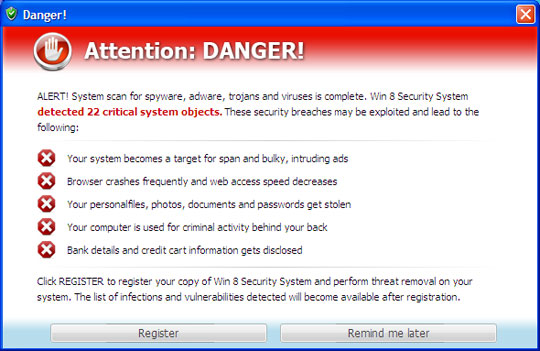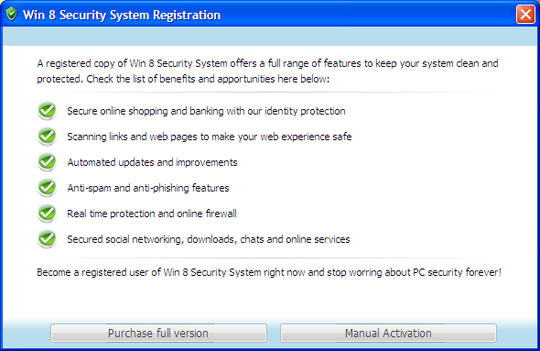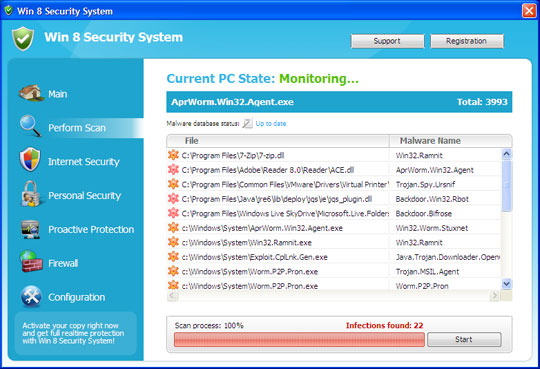TROJ_FAKEAV.SMW8
Rogue:Win32/Winwebsec (Microsoft), a variant of Win32/Kryptik.ALID trojan (Eset), Adware.CWSIEFeats (Symantec), Generic BackDoor.abd (McAfee)
Windows 2000, Windows XP, Windows Server 2003


Threat Type: Trojan
Destructiveness: No
Encrypted: Yes
In the wild: Yes
OVERVIEW
Downloaded from the Internet
This FAKEAV malware disguises itself as an antivirus specifically made for the Windows 8 operating system. This particular FAKEAV variant was seen in October 2012, which is the same month Windows 8 was released to the public.
This Trojan arrives on a system as a file dropped by other malware or as a file downloaded unknowingly by users when visiting malicious sites.
It connects to certain websites to send and receive information.
It displays a window where users can purchase this fake antivirus program.
TECHNICAL DETAILS
611,328 bytes
EXE
Yes
27 Oct 2012
Connects to URLs/IPs, Displays message/message boxes
Arrival Details
This Trojan arrives on a system as a file dropped by other malware or as a file downloaded unknowingly by users when visiting malicious sites.
Installation
This Trojan drops the following copies of itself into the affected system and executes them:
- %Application Data%\{random}.exe
(Note: %Application Data% is the current user's Application Data folder, which is usually C:\Documents and Settings\{user name}\Application Data on Windows 2000, XP, and Server 2003, or C:\Users\{user name}\AppData\Roaming on Windows Vista and 7.)
It drops the following files:
- %Desktop%\Buy Win 8 Security System.lnk
- %Start Menu\Programs\Win 8 Security System\Buy Win 8 Security System.lnk
- %Start Menu\Programs\Win 8 Security System\Launch Win 8 Security System.lnk
- %System%\drivers\{random 2}.sys
(Note: %Desktop% is the current user's desktop, which is usually C:\Documents and Settings\{User Name}\Desktop on Windows 2000, XP, and Server 2003, or C:\Users\{user name}\Desktop on Windows Vista and 7.. %System% is the Windows system folder, which is usually C:\Windows\System32.)
It creates the following folders:
- %Start Menu%\Programs\Win 8 Security System
(Note: %Start Menu% is the current user's Start Menu folder, which is usually C:\Windows\Start Menu or C:\Documents and Settings\{User name}\Start Menu on Windows 2000, XP, and Server 2003, or C:\Users\{user name}\AppData\Roaming\Microsoft\Windows\Start Menu on Windows Vista and 7.)
Autostart Technique
This Trojan adds the following registry entries to enable its automatic execution at every system startup:
HKEY_CURRENT_USER\Software\Microsoft\
Windows\CurrentVersion\Run
{random}.exe = "%Application Data%\{random}.exe"
Other System Modifications
This Trojan adds the following registry keys:
HKEY_CURRENT_USER\Software\Microsoft\
Windows\CurrentVersion\Internet Settings\
ZoneMap\Ranges\Range1
HKEY_LOCAL_MACHINE\SYSTEM\CurrentControlSet\
Enum\Root\LEGACY_{random 3}
HKEY_LOCAL_MACHINE\SYSTEM\CurrentControlSet\
Services\{random 2}
HKEY_LOCAL_MACHINE\SYSTEM\CurrentControlSet\
Enum\Root\ LEGACY_{random 2}
It adds the following registry entries:
HKEY_CURRENT_USER\Software\Microsoft\
Windows\CurrentVersion\Internet Settings
GlobalUserOffline = "0"
HKEY_CURRENT_USER\Software\Microsoft\
Windows\CurrentVersion\Internet Settings\
ZoneMap\Ranges\Range1
* = "1"
HKEY_CURRENT_USER\Software\Microsoft\
Windows\CurrentVersion\Internet Settings\
ZoneMap\Ranges\Range1
:Range = "127.0.0.1"
HKEY_CURRENT_USER\Software\Microsoft\
Windows NT
BuildVersion = "0"
HKEY_CURRENT_USER\Software\Microsoft\
Windows NT
BuildNumber = "0"
HKEY_LOCAL_MACHINE\SYSTEM\CurrentControlSet\
Enum\Root\LEGACY_{random 3}\
0000
DeviceDesc = "{random}.exe"
HKEY_LOCAL_MACHINE\SYSTEM\CurrentControlSet\
Enum\Root\LEGACY_{random 2}\
0000
Service = "random 2"
Other Details
This Trojan connects to the following website to send and receive information:
- {BLOCKED}t.com
Rogue Antivirus Routine
This Trojan displays the following fake alerts:
The following window is displayed for users to purchase the fake antivirus program:
It displays the following window and pretends to scan the system:
SOLUTION
9.300
9.490.01
27 Oct 2012
9.491.00
28 Oct 2012
Step 1
Before doing any scans, Windows XP, Windows Vista, and Windows 7 users must disable System Restore to allow full scanning of their computers.
Step 2
Identify and terminate files detected as TROJ_FAKEAV.SMW8
- Windows Task Manager may not display all running processes. In this case, please use a third-party process viewer, preferably Process Explorer, to terminate the malware/grayware/spyware file. You may download the said tool here.
- If the detected file is displayed in either Windows Task Manager or Process Explorer but you cannot delete it, restart your computer in safe mode. To do this, refer to this link for the complete steps.
- If the detected file is not displayed in either Windows Task Manager or Process Explorer, continue doing the next steps.
Step 3
Delete this registry key
Important: Editing the Windows Registry incorrectly can lead to irreversible system malfunction. Please do this step only if you know how or you can ask assistance from your system administrator. Else, check this Microsoft article first before modifying your computer's registry.
- In HKEY_CURRENT_USER\Software\Microsoft\Windows\CurrentVersion\Internet Settings\ZoneMap\Ranges
- Range1
- Range1
- In HKEY_LOCAL_MACHINE\SYSTEM\CurrentControlSet\Enum\Root
- LEGACY_{random 3}
- LEGACY_{random 3}
- In HKEY_LOCAL_MACHINE\SYSTEM\CurrentControlSet\Services
- {random 2}
- {random 2}
- In HKEY_LOCAL_MACHINE\SYSTEM\CurrentControlSet\Enum\Root
- LEGACY_{random 2}
- LEGACY_{random 2}
Step 4
Delete this registry value
Important: Editing the Windows Registry incorrectly can lead to irreversible system malfunction. Please do this step only if you know how or you can ask assistance from your system administrator. Else, check this Microsoft article first before modifying your computer's registry.
- In HKEY_CURRENT_USER\Software\Microsoft\Windows\CurrentVersion\Internet Settings
- GlobalUserOffline = "0"
- GlobalUserOffline = "0"
- In HKEY_CURRENT_USER\Software\Microsoft\Windows NT
- BuildVersion = "0"
- BuildVersion = "0"
- In HKEY_CURRENT_USER\Software\Microsoft\Windows NT
- BuildNumber = "0"
- BuildNumber = "0"
- In HKEY_CURRENT_USER\Software\Microsoft\Windows\CurrentVersion\Run
- {random}.exe = "%Application Data%\{random}.exe"
- {random}.exe = "%Application Data%\{random}.exe"
Step 5
Search and delete this folder
- %Start Menu%\Programs\Win 8 Security System
Step 6
Search and delete these files
- %Desktop%\Buy Win 8 Security System.lnk
- %Start Menu\Programs\Win 8 Security System\Buy Win 8 Security System.lnk
- %Start Menu\Programs\Win 8 Security System\Launch Win 8 Security System.lnk
- %System%\drivers\{random 2}.sys
Step 7
Restart in normal mode and scan your computer with your Trend Micro product for files detected as TROJ_FAKEAV.SMW8. If the detected files have already been cleaned, deleted, or quarantined by your Trend Micro product, no further step is required. You may opt to simply delete the quarantined files. Please check this Knowledge Base page for more information.
Did this description help? Tell us how we did.




